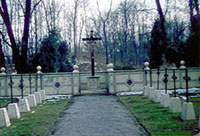
Marist Cemetery
In 1909 Brother Charles Camille,
assistant master of novices, died from meningitis after an illness of
only three days. Thus, the brothers decided to establish their own cemetery
in a small hollow at the south end of  the
property and Brother Charles was the first to be buried there. In 1913
Brother Angelicus, assistant general, urged the Provincial Council to
make this the definitive grave site and to beautify it.
the
property and Brother Charles was the first to be buried there. In 1913
Brother Angelicus, assistant general, urged the Provincial Council to
make this the definitive grave site and to beautify it.
It was modeled on traditional cemeteries in rural France. In 1921 it was surrounded by a white stone wall built by Brother Paul Acyndinus. Each grave, which was dug by the novices, was marked with a cross monument displaying biographical information such as date of birth, death and number of years with vows. As the cemetery expanded, the rock encountered made the regular use of a jack hammer necessary. The last grave was filled in 1953, and a larger cemetery was developed on the Marist Brothers' property in Esopus, New York.
 This
photo shows how the cemetery looked for a period of 80 years. It was not
large, containing only 48 graves. The graves were laid very close to one
another with a head stone marking each grave.
This
photo shows how the cemetery looked for a period of 80 years. It was not
large, containing only 48 graves. The graves were laid very close to one
another with a head stone marking each grave.
In 1960, the college purchased eight acres south of the cemetery from the New York Central Railroad. For about a decade the college filled in the field between the cemetery and the railroad spur which made the hollow more pronounced. By 1972 the area south of the cemetery became the obvious choice for a modern field house.
The first choice was to move the remains from the Poughkeepsie cemetery to the one in Esopus. The college attorneys warned that New York State had strict laws concerning the relocation of graves. Permission of the heirs had to be obtained, and since the deceased were never married, the 'heirs' were their siblings and their descendants. Since most of them had lived in France, this made relocation of the cemetery virtually impossible.
Brother Nilus Vincent Donnelly suggested that the cemetery remain in place, but the ground be filled to the height of the surrounding areas. He personally laid the individual grave markers over each grave, then bulldozed the walls inward and began the processing of adding 20 feet of fill. He noted the exact boundaries of the cemetery and the college agreed never to build on the site.
 The college purchased a large single monument listing the names of those
buried in the cemetery and placed it over the cemetery grounds. The names
are also included in a special plaque at the base of the Calvary scene
in the Esopus cemetery.
The college purchased a large single monument listing the names of those
buried in the cemetery and placed it over the cemetery grounds. The names
are also included in a special plaque at the base of the Calvary scene
in the Esopus cemetery.
